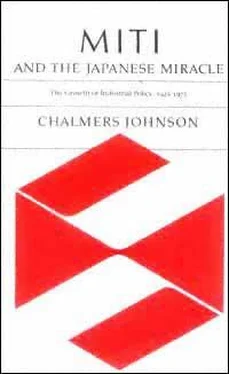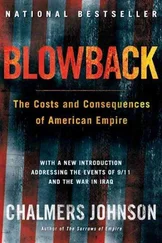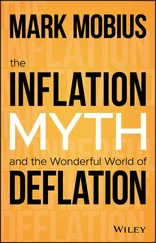Chalmers Johnson - MITI and the Japanese miracle
Здесь есть возможность читать онлайн «Chalmers Johnson - MITI and the Japanese miracle» весь текст электронной книги совершенно бесплатно (целиком полную версию без сокращений). В некоторых случаях можно слушать аудио, скачать через торрент в формате fb2 и присутствует краткое содержание. Год выпуска: 2007, Издательство: Stanford University Press, Жанр: Старинная литература, на английском языке. Описание произведения, (предисловие) а так же отзывы посетителей доступны на портале библиотеки ЛибКат.
- Название:MITI and the Japanese miracle
- Автор:
- Издательство:Stanford University Press
- Жанр:
- Год:2007
- ISBN:нет данных
- Рейтинг книги:3 / 5. Голосов: 1
-
Избранное:Добавить в избранное
- Отзывы:
-
Ваша оценка:
- 60
- 1
- 2
- 3
- 4
- 5
MITI and the Japanese miracle: краткое содержание, описание и аннотация
Предлагаем к чтению аннотацию, описание, краткое содержание или предисловие (зависит от того, что написал сам автор книги «MITI and the Japanese miracle»). Если вы не нашли необходимую информацию о книге — напишите в комментариях, мы постараемся отыскать её.
MITI and the Japanese miracle — читать онлайн бесплатно полную книгу (весь текст) целиком
Ниже представлен текст книги, разбитый по страницам. Система сохранения места последней прочитанной страницы, позволяет с удобством читать онлайн бесплатно книгу «MITI and the Japanese miracle», без необходимости каждый раз заново искать на чём Вы остановились. Поставьте закладку, и сможете в любой момент перейти на страницу, на которой закончили чтение.
Интервал:
Закладка:
Another way to make this distinction is to consider a state's priorities in economic policy. In the plan-rational state, the government will give greatest precedence to industrial policy, that is, to a concern with the structure of domestic industry and with promoting the structure that enhances the nation's international competitiveness. The very existence of an industrial policy implies a strategic, or goal-oriented, approach to the economy. On the other hand, the market-rational state usually will not even have an industrial policy (or, at any rate, will not recognize it as such). Instead, both its domestic and foreign economic policy, including its trade policy, will stress rules and
Page 20
reciprocal concessions (although perhaps influenced by some goals that are not industrially specific, goals such as price stability or full employment). Its trade policy will normally be subordinate to general foreign policy, being used more often to cement political relationships than to obtain strictly economic advantages.
These various distinctions are useful because they draw our attention to Japan's emergence, following the Meiji Restoration of 1868, as a developmental, plan-rational state whose economic orientation was keyed to industrial policy. By contrast, the United States from about the same period took the regulatory, market-rational path keyed to foreign policy. In modern times Japan has always put emphasis on an overarching, nationally supported goal for its economy rather than on the particular procedures that are to govern economic activity. The Meiji-era goal was the famous
fukokukyohei
* (rich country, strong military) of the late nineteenth and early twentieth centuries. This was followed during the 1930's and 1940's by the goals of depression recovery, war preparation, war production, and postwar recovery. From about 1955, and explicitly since the Income-doubling Plan of 1960, the goal has been high-speed growth, sometimes expressed as "overtake Europe and America" (
Obei*
ni oikose
). Amaya lists the goals of the past century in detail:
shokusan
kogyo
* (increase industrial production),
fukoku-kyohei
(rich country, strong military),
seisanryoku
kakuju
* (expand productive capacity),
yushutsu
shinko
* (promote exports),
kanzen
koyo
* (full employment), and
kodo
*
seicho
* (high-speed growth).
42
Only during the 1970's did Japan begin to shift to a somewhat regulatory, foreign-policy orientation, just as America began to show early signs of a new developmental, industrial-policy orientation. But the Japanese system remains plan rational, and the American system is still basically market rational.
43
This can be seen most clearly by looking at the differences between the two systems in terms of economic and political decision-making. In Japan the developmental, strategic quality of economic policy is reflected within the government in the high position of the so-called economic bureaucrats, that is, the officials of the ministries of Finance, International Trade and Industry, Agriculture and Forestry, Construction, and Transportation, plus the Economic Planning Agency. These official agencies attract the most talented graduates of the best universities in the country, and the positions of higher-level officials in these ministries have been and still are the most prestigious in the society. Although it is influenced by pressure groups and political claimants, the elite bureaucracy of Japan makes most major decisions, drafts virtually all legislation, controls the national budget, and is the source of
Page 21
all major policy innovations in the system. Equally important, upon their retirement, which is usually between the ages of 50 and 55 in Japan, these bureaucrats move from government to powerful positions in private enterprise, banking, the political world, and the numerous public corporationsa direction of elite mobility that is directly opposite to that which prevails in the United States.
44
The existence of a powerful, talented, and prestige-laden economic bureaucracy is a natural corollary of plan rationality.
In market-rational systems such as the United States, public service does not normally attract the most capable talent, and national decision-making is dominated by elected members of the professional class, who are usually lawyers, rather than by the bureaucracy. The movement of elites is not from government to the private sector but vice versa, usually through political appointment, which is much more extensive than in Japan. The real equivalent of the Japanese Ministry of International Trade and Industry in the United States is not the Department of Commerce but the Department of Defense, which by its very nature and functions shares MITI's strategic, goal-oriented outlook. In fact, the pejorative connotations in the United States of terms such as "Japan, Inc." are similar to those surrounding the domestic expression "military-industrial complex" referring to a close working relationship between government and business to solve problems of national defense. (Not to be outdone, some Japanese have taken to calling the Japanese government-business relationship a ''bureaucratic-industrial complex.")
45
American economic decisions are made most often in Congress, which also controls the budget, and these decisions reflect the market-rational emphasis on procedures rather than outcomes. During the 1970's Americans began to experiment with industrial policy bureaucracies such as the Department of Energy, but they are still rather wary of such organizations, whose prestige remains low.
Another way to highlight the differences between plan rationality and market rationality is to look at some of the trade-offs involved in each approach. First, the most important evaluative standard in market rationality is "efficiency." But in plan rationality this takes lower precedence than "effectiveness." Both Americans and Japanese tend to get the meanings of efficiency and effectiveness mixed up. Americans often and understandably criticize their official bureaucracy for its inefficiency, failing to note that efficiency is not a good evaluative standard for bureaucracy. Effectiveness is the proper standard of evaluation of goal-oriented strategic activities.
46
On the other hand, Japanese continue to tolerate their wildly inefficient and even inap-
Page 22
propriate agricultural structure at least in part because it is mildly effective: it provides food that does not have to be imported.
Second, both types of systems are concerned with "externalities," or what Milton Friedman has called "neighborhood effects"an example would be the unpriced social costs of production such as pollution. In this instance, however, the plan-rational system has much greater difficulty than the market-rational system in identifying and shifting its sights to respond to effects external to the national goal. The position of the plan-rational system is like that of a military organization: a general is judged by whether he wins or loses. It would be good if he would also employ an economy of violence (be efficient), but that is not as important as results. Accordingly, Japan persisted with high-speed industrial growth long after the evidence of very serious environmental damage had become common knowledge. On the other hand, when the plan-rational system finally shifts its goals to give priority to a problem such as industrial pollution, it will commonly be more effective than the market-rational system, as can be seen in the comparison between the Japanese and American handling of pollution in the 1970's.
Читать дальшеИнтервал:
Закладка:
Похожие книги на «MITI and the Japanese miracle»
Представляем Вашему вниманию похожие книги на «MITI and the Japanese miracle» списком для выбора. Мы отобрали схожую по названию и смыслу литературу в надежде предоставить читателям больше вариантов отыскать новые, интересные, ещё непрочитанные произведения.
Обсуждение, отзывы о книге «MITI and the Japanese miracle» и просто собственные мнения читателей. Оставьте ваши комментарии, напишите, что Вы думаете о произведении, его смысле или главных героях. Укажите что конкретно понравилось, а что нет, и почему Вы так считаете.












